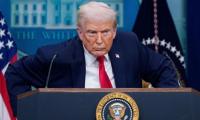In less than eight years, Islamabad has been under siege for 170 days
LAHORE: As Islamabad braces up for yet another long march in January 2021, announced this time around by an All Parties Conference (APC) spearheaded by country’s major ruling political parties of yesteryear, the former premier Nawaz Sharif-led PML-N and ex-president Asif Zardari’s PPP against the incumbent regime, history shows that the Pakistani capital has stood the test of time on many such occasions in the past.
In fact, as research conducted by the “Jang Group and Geo Television Network” shows, that the restive Islamabad has literally remained under siege for 170 days during the major sit-ins staged on its soil since January 14, 2013 or little less than eight years, when the Pakistan Awami Tehreek (PAT) Chief Dr Tahirul Qadri had also chosen the cold, chilly and wet January for his eventful 2013 long march against the then-ruling Pakistan Peoples’ Party (PPP) government.
Dr Tahirul Qadri has featured in two of the four major sit-ins in Islamabad, which is now used to hosting invasions of rebellious crowds from both political and religious outfits, which had even gone on to besiege some highly sensitive buildings like the Parliament House, Supreme Court of Pakistan, the President House, Prime Minister House, the state-run radio and TV stations during these onslaughts, besides threatened the PPP, PML-N and PTI governments.
The 18-day long 2019 Azadi march to Islamabad was led by Maulana Fazlur Rehman from October 27, 2019 to November 13 of the same year, whereby he had vehemently opposed Premier Imran Khan and had demanded his resignation.
Tens of thousands of protesters had followed Fazlur Rehman, who had resorted to the streets amidst strict media censorship. The march was called-off on November 13, 2019 and was converted to a blockade of major roads as “Plan B.”
After Nawaz Sharif had left Pakistan for the UK on an air ambulance on November 19, 2019 for treatment, the Plan B involving blockade of roads was also called-off. Analysts have divergent opinions on the march's outcome. Some say it failed, others are of the opinion that it achieved its desired result of putting pressure on the government and forced it to allow Nawaz Sharif to fly abroad for treatment despite being a convict.
Yet another sit-in that paralysed life in the Pakistani capital for 22 days was organised by the Tehreek-e-Labaik and the Sunni Tehreek on November 8, 2017, after the PML-N government and the protesters had signed an agreement, facilitated by the Pakistan Army.
However, the truce was reached following Law Minister Zahid Hamid’s resignation. According to the agreement, an inquiry board would be set up to take action against those responsible for the controversial amendment to the Finality of Prophet hood declaration for electoral candidates within 30 days.
On January 14, 2013, Dr Tahirul Qadri had started this long march from his Model Town Lahore residence to Islamabad’s Parliament D-Chowk via the Grand Trunk Road. Qadri had also called for a pre-election interim government to be appointed with input from the country's judiciary and military.
PAT’s January 14 to 17, 2013 long march from Lahore to Islamabad had culminated after the then PPP government had agreed to hold parleys with Qadri, who was demanding electoral reforms and dissolution of the National Assembly, all four provincial assemblies; and the disbanding of the country's Election Commission. While Qadri highlighted the corruption of the PPP regime from his bullet-proof container, he also called for the appointment of a pre-election interim government.
Remember, a series of corruption scandals had tainted the image of the PPP government between 2018 and 2013.
The Supreme Court of the time asked the then premier Yusuf Raza Gilani to write a letter to Swiss authorities and ensure the repatriation of $60 million allegedly stashed by president Asif Zardari in Alpine nation’s banks. Gilani defied the court, was held in contempt, and consequently shown the door by the apex court.
Schools in the capital and many businesses on the long march route had remained closed for four days during January 2013 and more than 10,000 police and paramilitary troops had to be deployed throughout Islamabad.
Prior to the march, the MQM had withdrawn because of security concerns. Qadri’s long march had ended after the then sitting prime minister Raja Pervaiz Ashraf, also found guilty of corruption in rental power projects while he was serving a the Minister for Water and Power, had signed a declaration with the PAT chief.
The government's negotiation committee was led by former prime minister Chaudhry Shujaat Hussain and had included members from all parties in the governing coalition.
On the night of January 17, 2013, as millions of Pakistanis witnessed it live on their television screens, Qadri told his followers gathered in Islamabad that he would be allowed to have a say in the appointment of an interim prime minister and the regime that would monitor the 2013 ballot exercise.
Supported behind the curtains by the Pakistan Tehreek-e-Insaf Chairman Imran Khan and Sheikh Rasheed Ahmed, Qadri was seen embracing government's representatives — many of whom were criticised in an extremely harsh tone by him!
A section of media had later reported that the Federal Investigation Agency had closed inquiries into Qadri and his party's funding for organising the long march, which was more of a scare.
Then followed the eventful PTI-PAT Azadi March, which was shown live day in and day out by the mainstream Pakistani television channels. This protest had lasted for 126 days between August 14, 2014 and December 17 of the same year, only to send ripples down the spine of the Nawaz Sharif government.
This march was organised to protest against the alleged rigging in the May 2013 polls which had seen Nawaz Sharif becoming prime minister for the third time. The Azadi March participants had demanded dismissal of the PML-N government and resignation of prime minister Nawaz Sharif. Other demands included electoral reforms, elimination of corruption and snap polls. We can all recall that this particular PTI and PAT initiative had lost steam in the middle following rebellious PTI leader Javed Hashmi's revelations and allegations that the PTI chief Imran Khan had plotted with Army to oust Nawaz Sharif.
In November 2017, it was revealed that an amount of Rs695 million, which was spent during the 2014 sit-in by the PTI and PAT in Islamabad, had not been recorded in the government’s cash book.
-
 Meghan Markle Set To Take Big Decision On Returning To UK For Invictus Games
Meghan Markle Set To Take Big Decision On Returning To UK For Invictus Games -
 Prince Harry To Leave Britain One Day Earlier Than Expected For THIS Reason
Prince Harry To Leave Britain One Day Earlier Than Expected For THIS Reason -
 The Way You Consume Sugar Could Be Affecting Your Health
The Way You Consume Sugar Could Be Affecting Your Health -
 Brooklyn Beckham Gets Backing From Vanessa Marcil Amid Feud With Parents
Brooklyn Beckham Gets Backing From Vanessa Marcil Amid Feud With Parents -
 OpenAI Uses AI To Detect Under 18 Users On ChatGPT
OpenAI Uses AI To Detect Under 18 Users On ChatGPT -
 Philippines To Lift Ban On Grok AI After Musk's Platform Commits To Fix Safety Concerns
Philippines To Lift Ban On Grok AI After Musk's Platform Commits To Fix Safety Concerns -
 Trump Vows ‘no Going Back’ On Greenland Ahead Of Davos Visit
Trump Vows ‘no Going Back’ On Greenland Ahead Of Davos Visit -
 Alexander Skarsgard Breaks Silence On Rumors He Is Bisexual
Alexander Skarsgard Breaks Silence On Rumors He Is Bisexual -
 King Charles Faces Rift With Prince William Over Prince Harry’s Invictus Games
King Charles Faces Rift With Prince William Over Prince Harry’s Invictus Games -
 Elon Musk’s Critique On ChatGPT Safety Draws Sharp Response From Sam Altman
Elon Musk’s Critique On ChatGPT Safety Draws Sharp Response From Sam Altman -
 Katherine Ryan Takes Aim At Brooklyn Beckham In Fierce Defense Of His Parents
Katherine Ryan Takes Aim At Brooklyn Beckham In Fierce Defense Of His Parents -
 How Timothy Busfield, Melissa Gilbert Really Feel After Release From Jail
How Timothy Busfield, Melissa Gilbert Really Feel After Release From Jail -
 OpenAI, Bill Gates Launch ‘Horizon 1000’ To Transform AI Healthcare In Africa
OpenAI, Bill Gates Launch ‘Horizon 1000’ To Transform AI Healthcare In Africa -
 Prince Harry Receives Praises For Exposing Dark Side Of British Tabloids
Prince Harry Receives Praises For Exposing Dark Side Of British Tabloids -
 Andrew Forces Beatrice, Eugenie To Lose $60 Million Safety Net Saved For Retirement
Andrew Forces Beatrice, Eugenie To Lose $60 Million Safety Net Saved For Retirement -
 Nvidia CEO Jensen Huang To Visit China To Push Re-entry Into AI Chip Market
Nvidia CEO Jensen Huang To Visit China To Push Re-entry Into AI Chip Market



